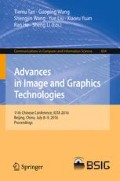Abstract
Objective: The technique of detecting moving regions has been playing an important role in computer vision and intelligent surveillance. Gaussian mixture models provide an advanced modeling approach for us. Although this method is very effective, it is not robust when there are some lighting changes and shadows in the scenes. This paper proposes a mixture model based on gradient images. Method: We firstly calculate gradient images of a video stream using the Scharr operator. We then mix RGB and gradient, and use a morphological approach to remove noise and connect moving regions. To further reduce false detection, we make an AND operation between two modeling results and result in final moving regions. Result: Finally, we use three video streams for analysis and comparison. Experiments show that this method has effectively avoided false detection regions resulting from lighting change and shadow, and improves the accuracy of detection. Conclusion: The approach demonstrates its promising characteristics and is more applicable in real-time detection.
Access this chapter
Tax calculation will be finalised at checkout
Purchases are for personal use only
References
Chen, Z., Ellis, T.: A self-adaptive Gaussian mixture model. Comput. Vis. Image Underst. 122, 35–46 (2014)
Yuan, C.F., Wang, C.X., Zhang, X.G., et al.: Video segmentation of illumination abrupt variation based On MOGs and gradient information. J. Image Graph. 12(11), 2068–2070 (2007)
Basri, I., Achamad, A.: Gaussian mixture models optimization for counting the numbers of vehicle by adjusting the region of interest under heavy traffic condition. In: International Seminar on Intelligent Technology and Its Applications, 2015 (ISITIA 2015), Surabaya (2015)
Qiao, S.J., Jin, K., Han, N., et al.: Trajectory prediction algorithm based on Gaussian mixture model. J. Softw. 26(5), 1048–1049 (2015)
Stauffer, C., Grimson, W.E.L.: Adaptive background mixture models for real-time tracking. In: Computer Vision and Pattern Recognition, 1999 (CVPR 1999), Fort Collins, CO (1999)
Cui, W.P., Shen, J.Z.: Moving target detection based on improved Gaussian mixture model. Opto-Electron. Eng. 37(4), 119–121 (2010)
Chen, X.Y.: The research and implementation of background modeling and updating algorithm based on mixture gaussian model. Northeastern University, Shenyang (2009)
Lei, L.Z.: On the edge detection method of digital image. Bull. Surv. Mapp. 40(3), 40–41 (2006)
Lu, Z.Q., Liang, C.: Edge thinning based on Sobel operator. J. Image Graph. 5(6), 516–518 (2000)
Yu, S.Q., Liu, R.Z.: Learning OpenCV, pp. 169–171. Tsinghua University Press, BeiJing (2009)
Pan, X.H., Zhao, S.G., Liu, Z.P., et al.: Detection of video moving objects by combining grads-based frame difference and background subtraction. Optoelectron. Technol. 29(1), 34–36 (2009)
Meng, Y.F., OuYang, N., Mo, J.W., et al.: A shadow removal algorithm with Gaussian mixture model. Comput. Simul. 27(1), 210–212 (2010)
Ma, Y.D., Zhu, W.F., An, S.X., et al.: Improved moving objects detection method based on Gaussian mixture model. Comput. Appl. 27(10), 2544–2546 (2007)
He, K., Ju, S.G., Lin, T., et al.: Image denoising on TV numerical computation. J. Univ. Electron. Sci. Technol. China 42(3), 459–461 (2013)
Gorelick, L., Blank, M., Shechtman, E., et al.: Actions as space-time shapes. IEEE Trans. Pattern Anal. Mach. Intell. 29(12), 2247–2248 (2007)
Fan, W.C., Li, X.Y., Wei, K., et al.: Moving target detection based on improved Gaussian mixture model. Comput. Sci. 42(5), 286–288 (2015)
Feng, W.H., Gong, S.R., Liu, C.P.: Foreground detection based on improved Gaussian mixture model. Comput. Eng. 37(19), 179–182 (2011)
Sun, D., Liu, J.F., Tang, X.L.: Edge detection based on density gradient. Chin. J. Comput. 32(2), 299–302 (2009)
Author information
Authors and Affiliations
Corresponding author
Editor information
Editors and Affiliations
Rights and permissions
Copyright information
© 2016 Springer Science+Business Media Singapore
About this paper
Cite this paper
Wang, M. et al. (2016). An Algorithm of Detecting Moving Foreground Based on an Improved Gaussian Mixture Model. In: Tan, T., et al. Advances in Image and Graphics Technologies. IGTA 2016. Communications in Computer and Information Science, vol 634. Springer, Singapore. https://doi.org/10.1007/978-981-10-2260-9_15
Download citation
DOI: https://doi.org/10.1007/978-981-10-2260-9_15
Published:
Publisher Name: Springer, Singapore
Print ISBN: 978-981-10-2259-3
Online ISBN: 978-981-10-2260-9
eBook Packages: Computer ScienceComputer Science (R0)

